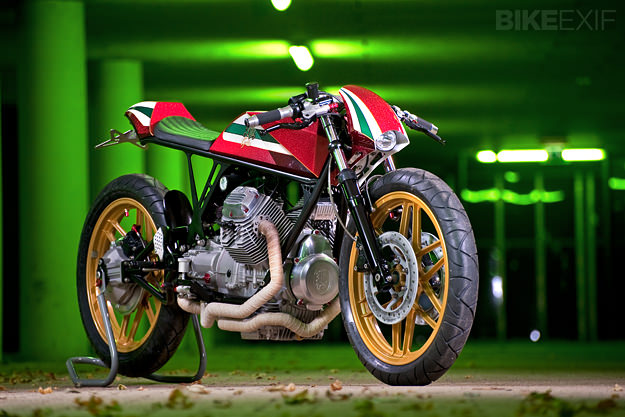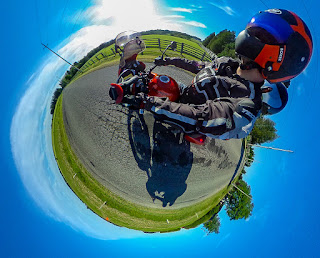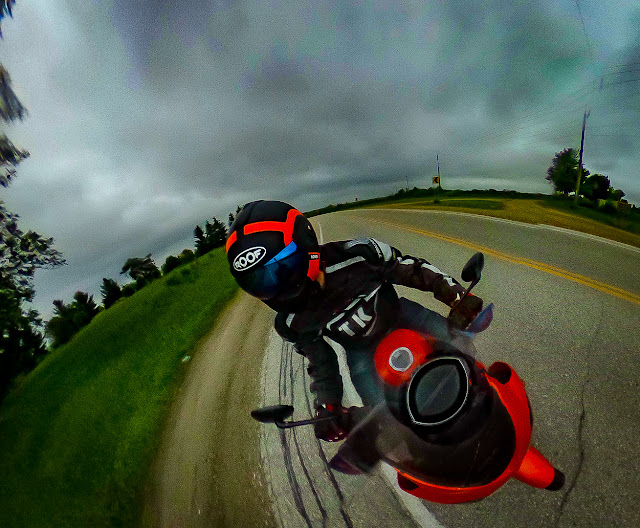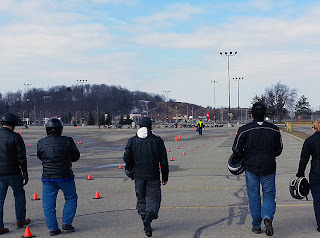Work’s been heavy as of late, and I’ve got the middle-aged itch to do something profound before I’m too old to do anything interesting. As usual, money and responsibility tie me to the earth, but in my more imaginative moments I wonder what I’d do with a year off and the money to do things that one day I’ll be too old and creaky to manage.
If I finished work at the end of June this year and had a year off I’d be back at work the following September. That would give me the better part of fifteen months to explore three of my favorite aspects of motorcycling: road racing, endurance riding and long distance adventure riding. In chronological order, here’s my year of living dangerously:
 |
It’s seat forward, middle & back,
in ergocycle but it looks like I *really*
like that Daytona. |
1… Road Racing: This spring get my race license, get a bike sorted and complete in the SOAR schedule over the summer.
A 12+ year old Triumph Daytona 600 would be a nice machine that fits into specific age (lost era) and displacement categories and wouldn’t be what everyone else is sitting on. I also fit on it quite well (see the suggestive gif on the right).
 Road racing would sharpen my riding skills and let me wrap my head around some of the more extreme dynamics of motorcycle riding in a controlled environment.
Road racing would sharpen my riding skills and let me wrap my head around some of the more extreme dynamics of motorcycle riding in a controlled environment.
Familiarity with high speed on a bike wouldn’t hurt for what I’m planning to do next, and racing over the summer would also focus my fitness training which would be helpful in building up to #2.
Costing a road racing season: ~$20,000 (including race prepping a bike and racing in a local series)
 |
Less than 50% usually finish, it’s
difficult, astonishing and viciously
exhausting, but finishing puts you in
a very small and exceptional group. |
2… Race the Dakar: Happening over New Years and into early 2017, finishing the Dakar would be the kind of thing that not many people manage. Dreamracer puts into perspective just how difficult this can be.
Leaving work at the end of June I’d be full-on training and preparing for the race. There are a number of Baja and other sand/desert focused races that would get me ready for the big one. There are also a lot of off road training courses available well into the fall. My goal would be to get licensed, certified and experienced in as many aspects of motorcycle racing as possible in the six months leading up to the Dakar.
Doing a Dakar would also be a fantastic fitness focus. With a clear goal in mind, it would be a lot easier to schedule and organize my fitness. A personal trainer and a clear targets would have me ready to take my best run at a Dakar, one of the toughest tests of mind and body ever devised. It would do a fantastic job of scratching that middle-aged urge to do something exceptional.
Costing of a Dakar: ~$98,000 Cdn
3… Ride Home: The Dakar raps up mid-January, the perfect time to begin a ride back to Canada! After resting up from the race I’d head south to Ushuaia at the beginning of February (summer time there) before riding back up the west coast through Chile.
A stop in Peru at Machu Picchu and then up the coast through Ecuador and into Columbia before loading on the Ferry in Cartegena to Panama around the one roadless bit in the Americas.

Once landed in Panama I make my way through Central America before pushing all the way up North America’s West Coast to the Arctic ocean in mid-summer (lots of sunlight!). The last leg has me finally heading south again and east across Canada and back home.
 |
The new Tiger would do a sterling
job of taking me the thirty three
thousand kilometres home. |
All told it would be just over thirty three thousand kilometres. Leaving Buenos Aires at the beginning of Februrary, and averaging 500kms a day (less on bad roads, more on good roads), I’d be looking at 68 days on the road straight. Fortunately, if I wrap up the trip at the end of July I’d have more like 180 days to do it, leaving lots of time to enjoy the magic I’d find along the way.
Cost of a trip like this? A week on the road is cheaper in South and Central America than North America. If this is a 160 day trip (with 20 days for potential slowdowns to stay within the 180 day/6 month goal), then the money can be roughly estimated using these approximations:
- $150/day (gas, food, lodging, expenses) in South & Central America
- $250 a day in North America
The raw numbers break down like this:
- 14,500kms in South America (43% of the trip) – 69 days = $10,350
- 5600kms in Central America (17% of the trip) – 27 days = $4050
- 13560kms in North America (40% of the trip) – 64 days = $16,000
For a total of $30,400 for the trip + $15,000+shipping to Argentina for a new Tiger
For the low, low price of about $150,000, I’d have a year of unique challenges, once in a lifetime experiences and get a chance to do three things that will only become more and more impossible as I get older. Some people like the idea of a holiday where they can do nothing, but that isn’t for me. I’ll take the challenge any day, if only I had the money and the time money gives.
The goal once I was home and back to daily life would be to collate the notes and media from this year of living dangerously into written and visual mediums. Being able to produce a video and book(s) out of this experience would be the cherry on top.
Besides a fantastic set of memories, some new skills and the material needed to write an epic tale, I’d also have a race bike ready to compete on again the next summer. That year of living dangerously might persist.

































